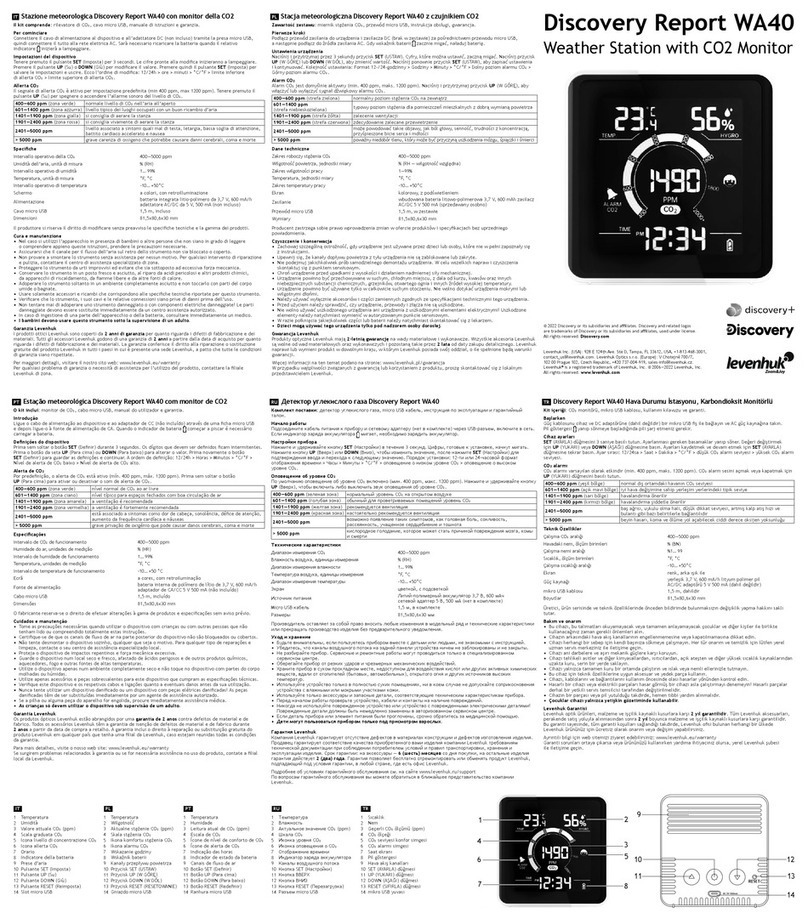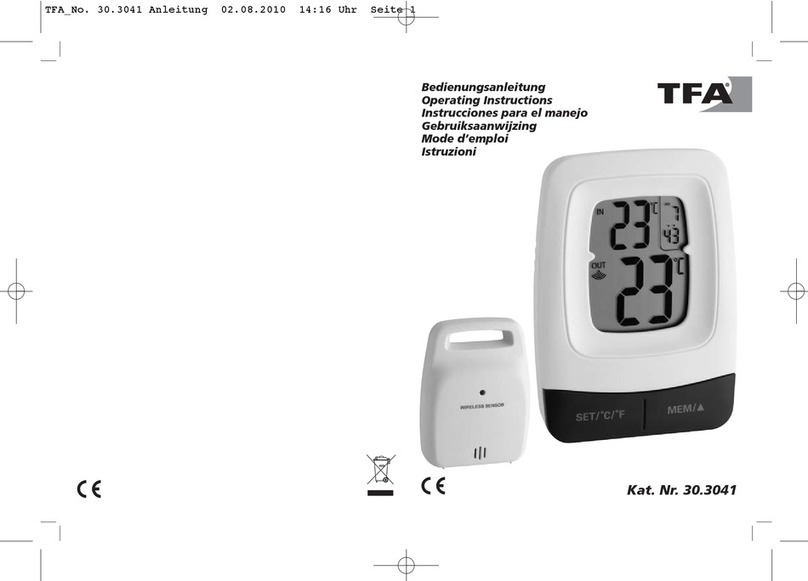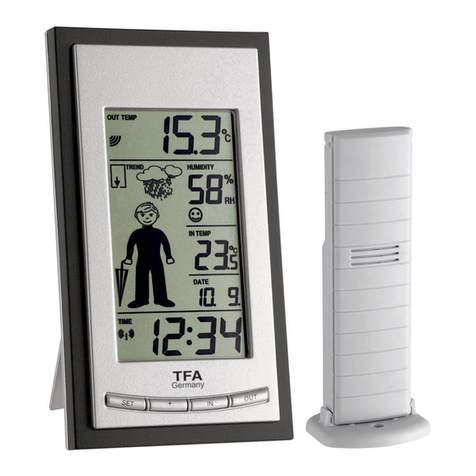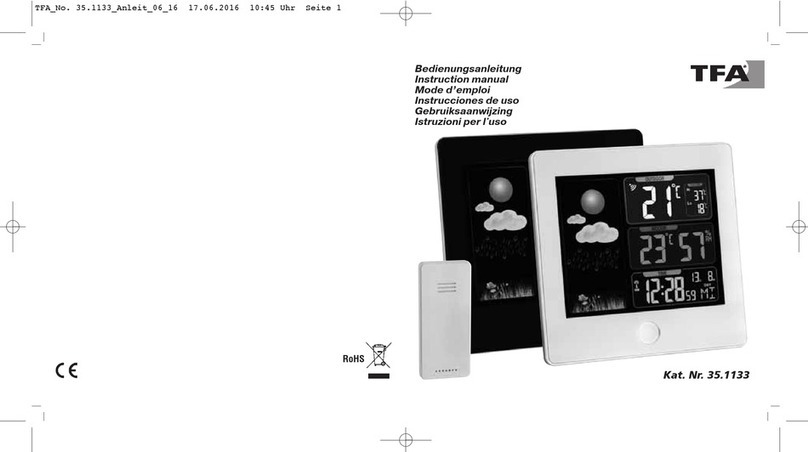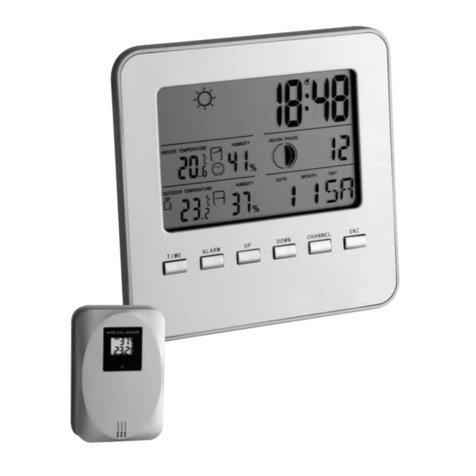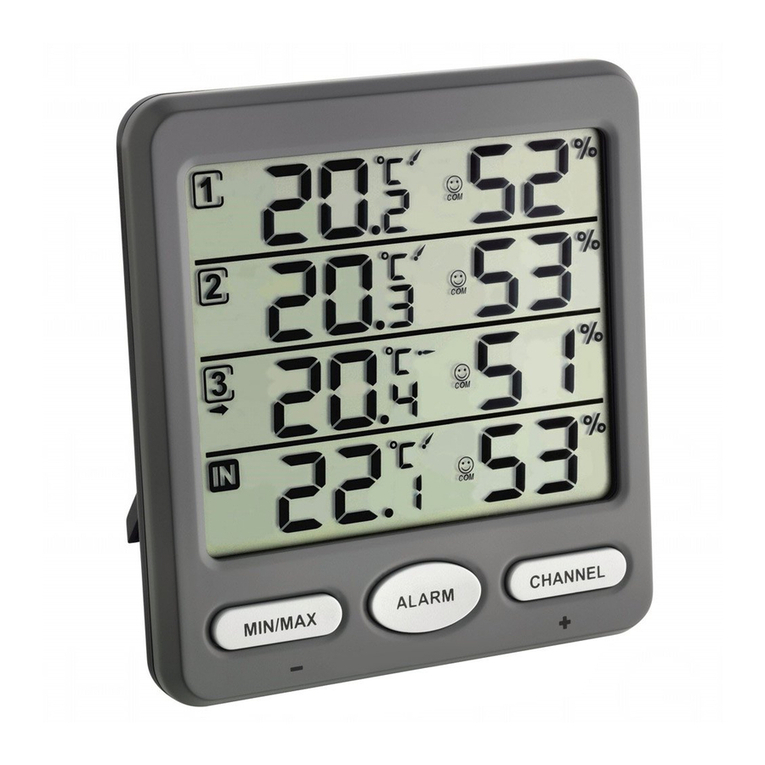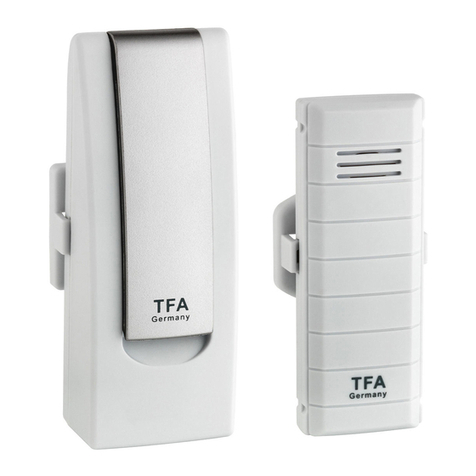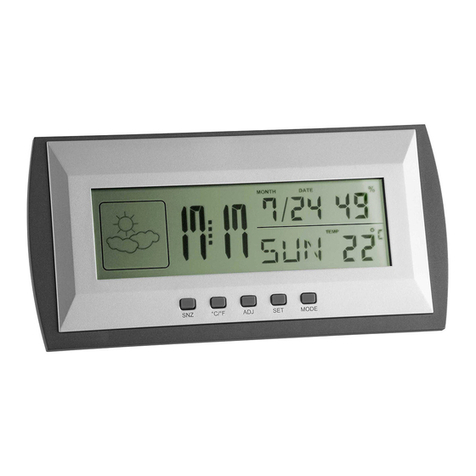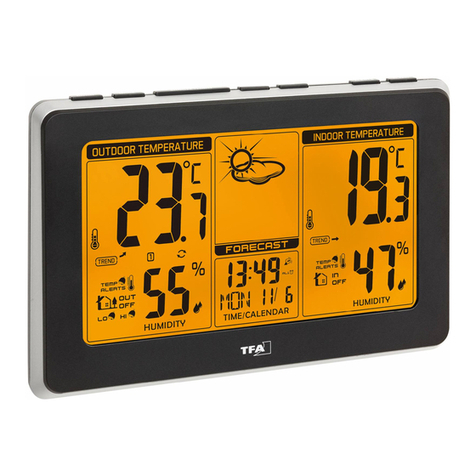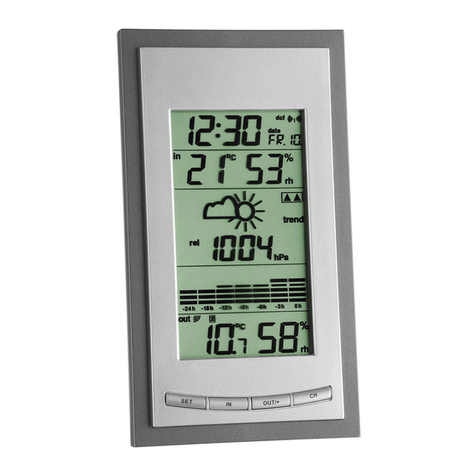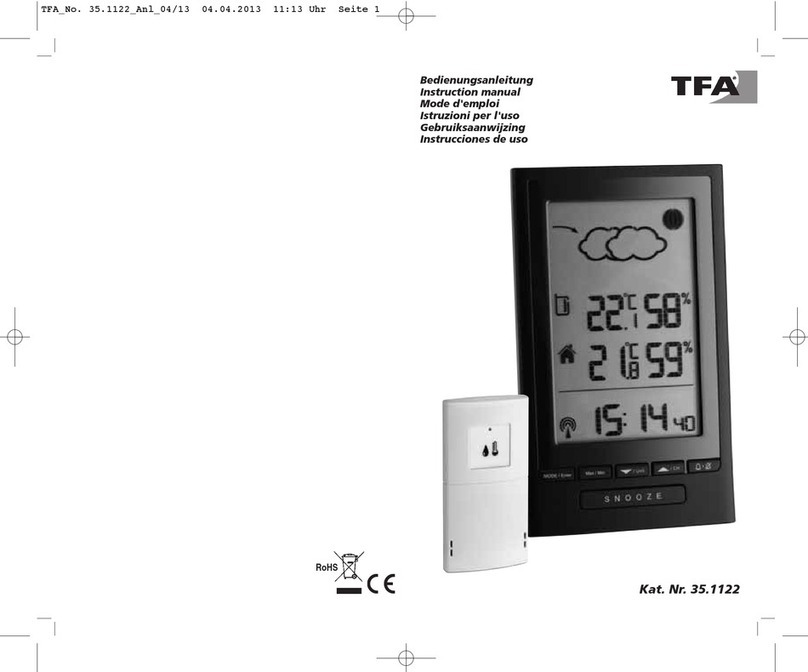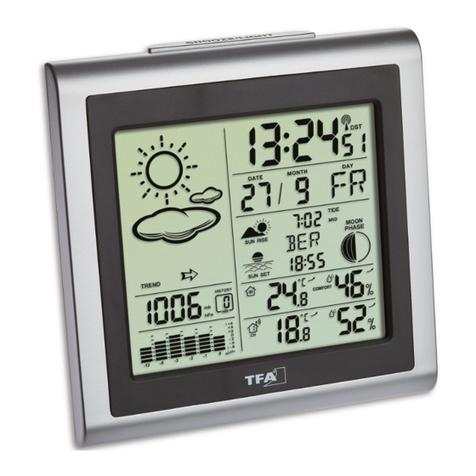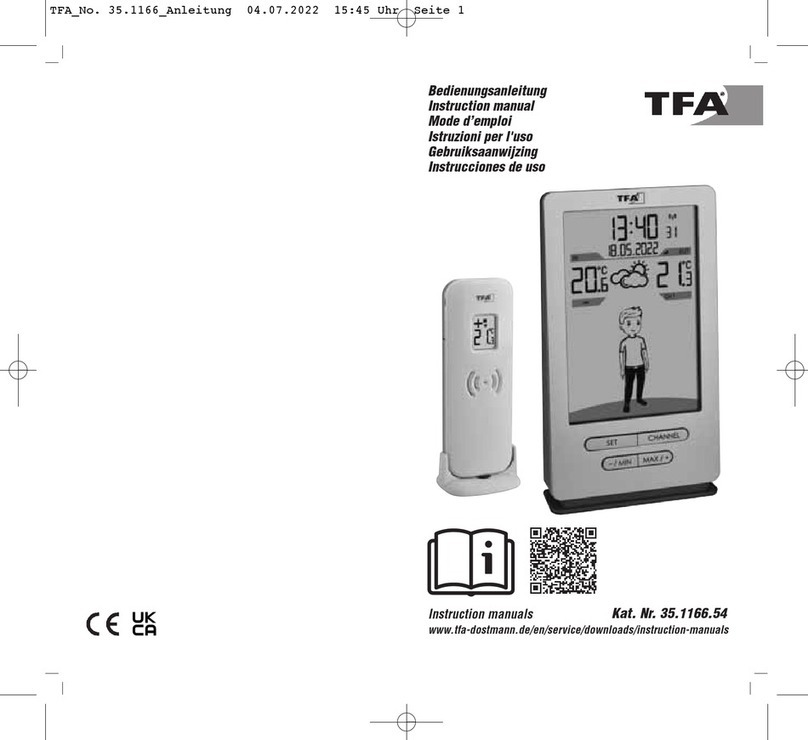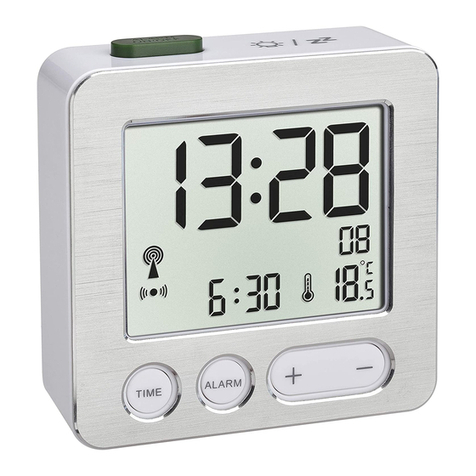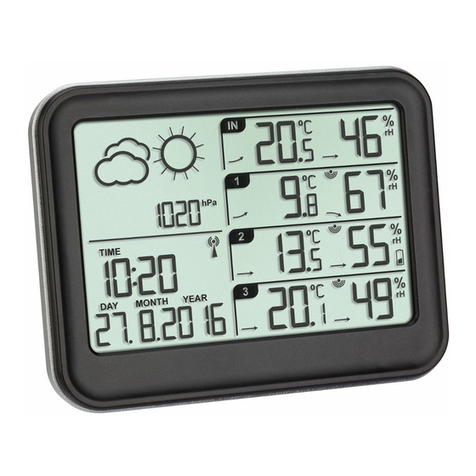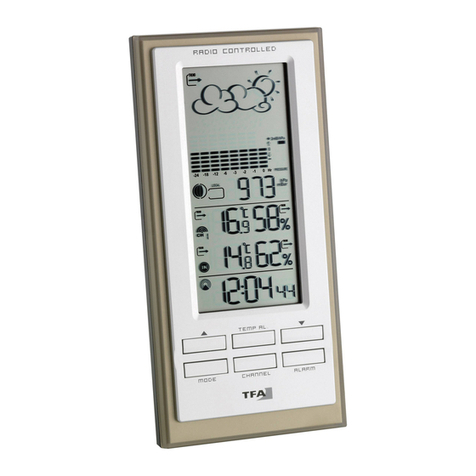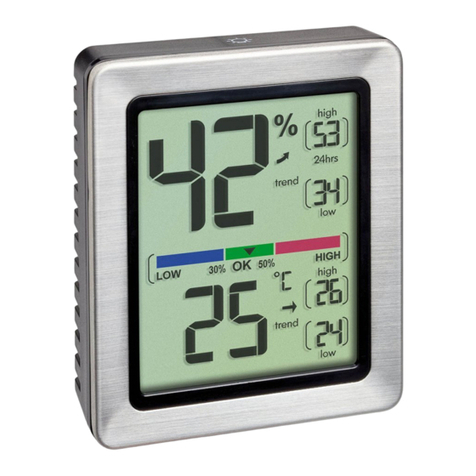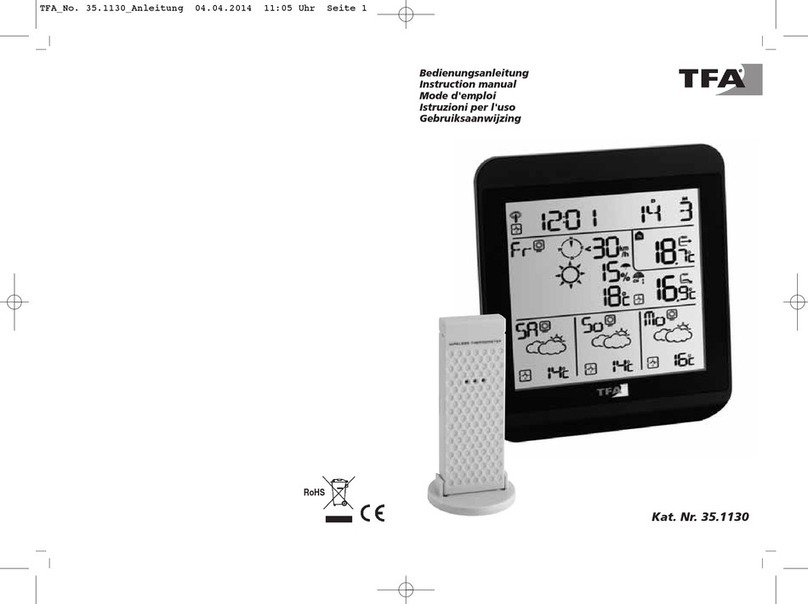SLIM-TOUCH – Wireless weather station
SLIM-TOUCH – Wireless weather station
16 17
6. Getting started and inserting the batteries into the outdoor trans-
mitter
• Place the basic station and the outdoor transmitter on a desk with a dis-
tance of approximately 1.5 meter. Avoid getting close to possible interfer-
ence sources (Electronic devices and radio installations).
• Open the battery compartment of the outdoor transmitter by pushing the
battery cover upwards with your thumb.
• Pay attention to the sealing ring.
• Insert two new batteries 1,5 V AA. Make sure the polarities are correct.
• All LCD segments will be displayed for a short time.
• The LCD light of the outdoor transmitter will be flashing.
• The actually measured outdoor temperature and humidity as well as the
channel number (1 default) are permanently shown on the display.
6.1 Inserting the batteries into the basic station and the reception of the out-
door values
• Open the battery compartment of the basic station.
• Insert two new batteries 1,5 V AAA. Make sure the polarities are correct.
• All LCD segments will be displayed for a short time.
• Afterwards the basic station is ready to receive the measured values of the
outdoor transmitter on channel 1. The reception waves beside the channel
number and “- - _ - -” will be flashing in the display of the outdoor values.
• As soon as the basic station receives the outdoor values, the values are per-
manently shown.
• If the reception of the outdoor values fails, “- - _ - -” stays on the display.
Check the batteries and try it again. Check if there is any source of inter-
ference.
• You can also start the outdoor transmitter search manually (for example
when the transmitter is lost or the batteries are changed).
•Touch the SNOOZE button and the control buttons appear on the display.
• Press and hold the CH button on the basic station.
• The reception waves beside the channel number will be flashing.
• As soon as the basic station receives the outdoor values, the values are per-
manently shown.
• The reception waves disappear.
6.2 Reception of the DCF frequency signal
• After the reception of outdoor values in channel 1, the clock is now trying
to receive the radio signal (the DCF signal will be received via the outdoor
transmitter on channel 1) and the DCF reception symbol will be flashing.
When the time code is received successfully after 3-10 minutes, the radio-
controlled time and the DCF reception symbol are displayed steadily on the
display.
• The DCF reception always takes place at 3:00, 4:00 and 5:00 o'clock in the
morning. If the reception is not successfully received at 5:00 clock, it shall be
held further attempts until 6:00 clock.
• Manual initialization of the DCF reception is always possible.
•Touch the SNOOZE button and the control buttons appear on the display.
• Press and hold the MEM button.
• The DCF reception symbol will be flashing.
• If there is no DCF reception possible, you have also the possibility to disable
the DCF reception manually (see: Manuel settings).
• There are three different reception symbols:
flashes – reception is active
stays – reception is good
No symbol – reception is deactivated
• If the clock cannot detect the DCF-signal (for example due to disturbances,
transmitting distance, etc.), the time can be set manually. The clock will
then work as a normal quartz clock. (see: Manual settings).
7. Radio-controlled time reception
The time base for the radio-controlled time is a cesium atomic clock operated
by the Physikalisch Technische Bundesanstalt Braunschweig. It has a time devi-
ation of less than one second in one million years. The time is coded and
transmitted from Mainflingen near Frankfurt via frequency signal DCF-77
(77.5 kHz) and has a transmitting range of approximately 1,500 km. Your
radio-controlled clock receives this signal, converts it to show the precise time.
Changeover from summer time or winter time is automatic. The quality of the
reception depends mainly on the geographic location. Normally there should
be no reception problems within a 1,500 km radius around Frankfurt.
Please take note of the following:
•
The recommended distance to any interfering sources like computer moni-
tors or TV sets is at least 1.5 - 2 meters.
•
Inside Ferro-concrete rooms (basements, superstructures), the received sig-
nal is naturally weakened. In extreme cases, please place the unit close to a
window to improve the reception.
•
During nighttime, the atmospheric interference is usually less severe and
reception is possible in most cases. A single daily reception is adequate to
keep the accuracy deviation under 1 second.
8. Operation
•Important: During the DCF reception (reception symbol will be flashing) the
buttons will not function.
• During the operation, all successful settings will be confirmed by a brief
beep tone.
• The instrument will automatically quit the setting mode if no button is
pressed for a lengthy period.
• Press and hold the ▼or ▲button in the setting mode for fast running.
8.1 Manual settings
Touch the SNOOZE button and the control buttons appear on the display.
•
Press and hold the MODE button in normal mode for three seconds to enter
the setting mode.
•
The 12-hour or 24-hour display format will be flashing.
•
Press the ▼or ▲button in normal mode to choose between 24- and 12 HR
system (AM or PM appears on the display).
•
Press the MODE button again and the setting sequence is shown as follows:
Time zone (0 default), hours, minutes, year, month/day sequence (American
version) or day/month sequence (European version), month, day, the lan-
guage of the day-of-the-week, the temperature (°C or °F) unit and the DCF
reception (ON default) and adjust the settings with the ▼or ▲ button.
•
Confirm the setting with the MODE button.
•
By a successfully reception of the DCF signal and if the DCF reception is acti-
vated (ON), the manually set time will be overwritten.
TFA_No. 35.1128_Anleit_04_14 07.04.2014 10:20 Uhr Seite 9

